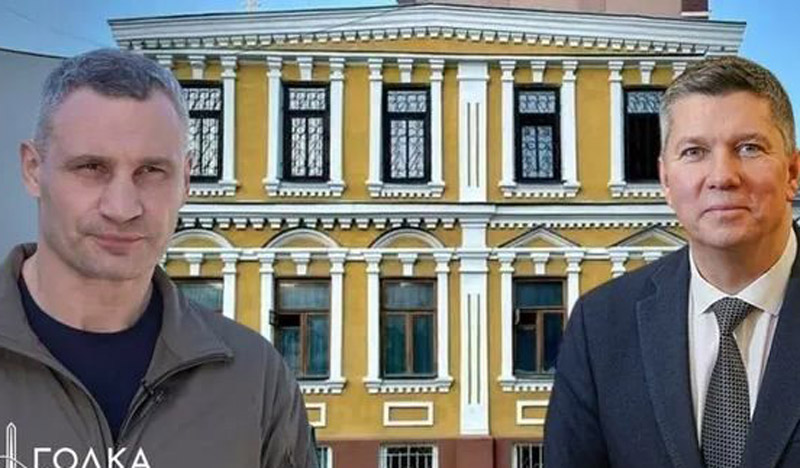Кто же на самом деле виноват в уничтожении исторической усадьбы Зеленских и как этого можно было избежать?


Снос усадьбы Зеленских в Киеве вызвал резонанс. Власти Киева кивали на центральную власть, а Минкультуры — на Виталия Кличко.
Не обошлось и без привлечения Временной специальной комиссии, которую создали как политический инструмент вместо того, чтобы вводить реальные реформы.
Власти Киева в свое время не приняли историко-архитектурный опорный план города, чтобы управлять застройкой столицы в ручном режиме. Но законодательство изменилось и уже несколько лет подряд мяч исключительно на поле Минкультуры. Но здесь саботируют выполнение Государственной антикоррупционной программы, и разработку подзаконных актов, необходимых для защиты культурного наследия.
Общественная инициатива «Игла» на примере усадьбы Зеленских исследовала, как работает система в интересах застройщиков.
(Не)обязательная государственная антикоррупционная политика
Неконтролируемая застройка исторических центров городов и связанные с этим коррупционные риски — проблема общегосударственного уровня. В Антикоррупционной стратегии на 2021-2025 годы (п. 3.5.2) для ее преодоления предусмотрено установление запрета нового строительства и реконструкции в пределах исторических ареалов в случае отсутствия историко-архитектурных опорных планов (ИАОП).
Для выполнения Антикорстратегии Кабмин в Государственной антикоррупционной программе предусмотрел разработку соответствующего законопроекта. Исполнитель — Минкультуры. А сделано все должно было быть и подано на рассмотрение Кабмина для дальнейшего внесения в парламент еще год назад.
Минкультуры ничего не сделало. Национальное агентство по вопросам предотвращения коррупции, контролирующее выполнение Государственной антикоррупционной программы, просто поставило в своей системе мониторинга отметку «Не выполнено», и на этом все успокоились.
Утвержденного ИАОП в Киеве нет. А усадьба Зеленских была расположена в центральном историческом ареале, и снесли ее под видом реконструкции. Выполнение мероприятий Государственной антикоррупционной программы обеспечило бы зданию защиту от уничтожения.
Выполнение этих мер является обязательным (ст. 18-1 Закона «О предотвращении коррупции»), за обеспечение их выполнения персональную ответственность несет в.и.о. министра Ростислав Карандеев (ст. 18-2). Историческое здание уничтожено, а руководство Минкультуры до сих пор на своих должностях.
И проблема не в единичном утраченном здании. За день до событий в Киеве Минкультуры сообщило об отмене судом научно-проектной документации по режимам использования исторического ареала Львова и связанных с этим рисках. Если бы министерство выполняло свои обязанности, то такие решения судов не снимали бы ограничения на высотное строительство в историческом городе, а приводили к прямо противоположному — полному запрету на строительство в историческом ареале.
Какой статус мог защитить здание в условиях, когда Минкультуры саботирует выполнение Государственной антикоррупционной программы?
Главный нарратив, который активно популяризировали в течение всего периода борьбы за сохранение этого исторического здания, — спасти можно только предоставив ему статус объекта культурного наследия.
Но такие заявления являются ошибочными. К объектам культурного наследия относятся только памятники и только что выявленные объекты культурного наследия. А в соответствии с государственными строительными нормами (ДБН Б.2.2-12: 2019, п. 13.2.4) запрещается снос также значительных и рядовых исторических зданий на территориях исторических ареалов и зон охраны памятников.
Для учета исторических зданий не предусмотрено специальных реестров или перечней. Они должны отображаться в историко-архитектурном опорном плане и другой научно-проектной документации по охране памятников. В случае отсутствия такой утвержденной документации возникают сложности с доведением соответствующего статуса исторического здания.
Если бы усадьба Зеленских получила статус объекта культурного наследия, это был бы самый надежный способ защиты ее от сноса. Но для этого здание должно иметь ценность, соответствующую установленным Кабмином критериям. Найти у него эту ценность не удалось, хотя ее тщательно искали и пытались доказать профильные общественные организации «Мапа Реновации» и «Наследие Киев».
Дом не соответствовал критериям памятников истории, потому что единственный связанный с ним известный человек — профессор русского языка и литературы Малинин, который открыто пропагандировал российскую имперскую политику в своих работах.
И требованиям к памятникам архитектуры он также не соответствовал. Это было заурядное здание конца XIX века, которое вследствие надстройки и частичного демонтажа не могло рассматриваться даже как ценный образец исторической застройки улицы. В 2004 году оно из одноэтажного превратилось в двухэтажное, а в 2018-2021 годах стало вдвое уже и на четверть короче, полностью потеряв историческую форму и пропорции.
Однако по результатам научных исследований усадьба Зеленских еще по состоянию на лето 2021 года была определена как значительное историческое здание. О чем сразу после демонтажа публично заявило Минкультуры, ссылаясь на данные проекта историко-архитектурного опорного плана Киева. Вот только этот документ лишь согласован Министерством в 2021 году, но не утвержден Киевсоветом.
Проект ИАОП без его утверждения Киевсоветом не способен защитить исторические здания от сноса. Минкультуры заявляло об этом еще 2 сентября 2021 года, когда было первое обострение ситуации вокруг усадьбы Зеленских.
С 26 мая 2022 года здание также находится в охранной зоне памятника архитектуры местного значения, расположенного на противоположной стороне улицы по адресу Конисского, 19. Это является следствием вступления в силу изменений в статью 32 Закона «Об охране культурного наследия», внесенными Законом №1423-IX о дерегуляции земельных отношений.
Указанные изменения, во-первых, императивно установили охранные зоны на расстоянии 100 м от территории памятников, если для них это не установлено отдельной научно-проектной документацией. Во-вторых, императивно запретили в таких случаях строительство, если его высота превышает разницу между расстоянием до памятника и двойной высотой памятника.
Усадьба Зеленских размещена настолько близко к памятнику на Конисского, 19, что можно и без измерения расстояний и высот констатировать: она в охранной зоне и строить на ее месте что-то выше старого здания запрещено законом.
Сносить усадьбу Зеленских, чтобы возвести на ее месте многоэтажный дом, не имело смысла. Но чиновники и активисты ни разу не озвучивали информацию о расположении здания в охранной зоне памятника и ограничении высоты строительства на его месте. Поэтому застройщик мог просто не знать об изменениях законодательства и новых ограничениях.
Почему даже арест в рамках уголовного производства не спас здание от уничтожения?
Защитить усадьбу от сноса должен был бы арест, наложенный постановлением Шевченковского райсуда в январе этого года. Но не спас. Чтобы понять, почему так, надо разматывать этот клубок с конца.
Во время заседания по избранию меры пресечения совладелец усадьбы и его адвокат заявили, что там происходила реконструкция на основании предусмотренных законодательством документов, а арест на здание был наложен незаконно.
Соответствует ли это действительности? К сожалению, да.
Еще более двух лет назад, 30 июня 2022 года, профильный департамент КГГА зарегистрировал уведомление о начале строительных работ по реконструкции помещений жилого дома.
Хотя документ и выдан на реконструкцию помещений, на его основании можно снести здание до фундамента и остаться чистым перед законом.
На уровне законодательства не установлено, какие именно строительные работы относятся к этому виду строительства. А по ДБН А.2.2-3: 2014 «Состав и содержание проектной документации на строительство» для реконструкции достаточно частичного сохранения элементов несущих конструкций. Поэтому застройщику достаточно оставить в земле хотя бы один кирпич от старого фундамента как этот самый «частично сохраненный элемент несущей конструкции» — и де-факто новое строительство превращается в де-юре реконструкцию.
Была ли какая-то коррупция в КГГА при регистрации этого сообщения? Нет, потому что у нас полная дерегуляция для небольших объектов. Если поданное уведомление заполнено правильно, его обязаны зарегистрировать.
Этот документ никогда не скрывали. Он есть в публичном доступе в Единой государственной электронной системе в сфере строительства. Но его существование не афишируют. Более того, манипулируют заявлениями, что на демонтаж здания разрешений не предоставляли. Чиновники формально не обманывают — уведомление не является разрешительным документом. Но умалчивают, что согласно действующему законодательству для сноса такого исторического здания разрешения и не нужны.
Арест на здание в январе этого года был наложен как на вещественное доказательство разрушения объекта культурного наследия. Но усадьба Зеленских никогда не была объектом культурного наследия.
Как поясняет в заявлении городская прокуратура, ходатайствовали о наложении ареста, поскольку указанный земельный участок входит в границы исторического ареала и поэтому на проведение строительных работ требуется разрешение Минкультуры. Вот только уже упомянутым выше Законом №1423-IX о дерегуляции земельных отношений требование на получение разрешения Минкультуры отменили еще с 1 января 2023 года (ч. 7 ст. 32 Закона «Об охране культурного наследия»).
Таким образом, арест был наложен на доказательство преступления, которое теоретически не могло быть совершено в данном случае. От нарушения этого неправомерного ареста теоретически не могло быть существенного вреда, поэтому его нарушение в соответствии с ч. 2 ст. 11 Уголовного кодекса не является уголовным правонарушением.
Также снос усадьбы Зеленских, вопреки утверждению прокуратуры, не может быть самовольным строительством на самовольно занятом земельном участке. У застройщика было предусмотрено законодательством уведомление о начале строительства, а право пользования земельным участком не требуется в случае реконструкции в пределах имеющихся фундаментов (ч. 4 ст. 34 Закона «О регулировании градостроительной деятельности»).
Описанная выше ситуация демонстрирует реальную глубину проблемы. Почти в центре Киева грубо снесено значительное историческое здание, а правоохранителям, чтобы снять общественное напряжение, приходится фальсифицировать уголовное дело против застройщика. И это является следствием несбалансированной дерегуляции в строительстве, которую последовательно проводит Верховная Рада в интересах строительного лобби.
Исправить ситуацию можно было, отменив регистрацию уведомления о начале строительства или предоставив доказательства, что усадьба Зеленских является значительным историческим зданием и ее запрещено сносить.
Для отмены регистрации уведомления о начале строительства обязательно нужно было провести проверку и установить факт нарушений при строительстве.
В условиях военного положения Кабмин (при отсутствии полномочий) фактически запретил проверки, позволив проводить только внеплановые на основании решения Мининфраструктуры и только «при наличии угрозы, имеющей негативное влияние на права, законные интересы, жизнь и здоровье человека, защиту окружающей природной среды и обеспечение безопасности государства, а также для выполнения международных обязательств». На первый взгляд проблем не должно быть — строительство, угрожающее сохранению традиционного характера исторической среды, по определению имеет негативное влияние на права и законные интересы человека.
Весной этого года КГГА предприняла попытку провести проверку строительства на Конисского. Информация об этом есть в письме КГГА по реализации петиции о защите усадьбы Зеленских.
Мининфраструктуры проводить проверку не позволило, сославшись на ответ Государственной инспекции градостроительства и архитектуры, согласно которому в документах не содержится материалов, свидетельствующих о наличии угрозы, которая имеет негативное влияние.
Можно было бы обвинять Департамент архстройконтроля КГГА в сознательном сливе вопроса в интересах застройщика, если бы не один нюанс. Согласно приказу Министерства, не заявитель, а ГИАМ должен изучать ситуацию и предоставлять письменное обоснование о наличии или отсутствии угроз.
То есть Мининфраструктуры с ГИАМ рассмотрели вопрос с усадьбой Зеленских и пришли к выводу, что демонтаж исторического здания не несет угрозы, которая имеет негативное влияние на права и законные интересы людей.
При наличии документов, подтверждающих статус усадьбы Зеленских как значительной исторической застройки и запрет ее сноса, возникала возможность эффективно противостоять демонтажу, даже если у застройщика было зарегистрировано уведомление о начале строительства.
За то время, пока Киевом руководил городской голова Виталий Кличко, за бюджетные средства было подготовлено два проекта ИАОП: первый был подан в Минкультуры в 2016 году, второй — в 2021-м. Ничто не мешало еще в 2017 году утвердить необходимый документ как внесение изменений в действующий Генеральный план города.
Но этого не произошло. ИАОП невыгоден и влиятельному строительному лобби, поскольку устанавливает ограничения на самую прибыльную застройку в историческом центре, и городской власти, поскольку лишает возможности ручного управления. А общественность не могла заставить Киевсовет это сделать, потому что законодательство не устанавливает никаких требований к срокам разработки и утверждения этого документа.
С проектом ИАОП 2021 года уже сложнее — его нельзя было утвердить, пока КГГА не обеспечит разработку научно-проектной документации по определению границ и режимов использования исторических ареалов. Это подчеркивало именно Минкультуры при согласовании проекта.
Но с 26 мая 2022 года эту документацию невозможно разработать и утвердить. Внесенные Законом №1423-IX изменения требовали от Кабмина утвердить порядок разработки и утверждения и определить состав и содержание такой документации. Это до сих пор не сделано, потому что Минкультуры сорвало подготовку проектов для утверждения правительством.
Вариант с разработкой и утверждением границ и режимов использования зон охраны упомянутого выше памятника на Конисского, 19, также невозможен с той же даты. Минкультуры сорвало подготовку проектов для утверждения Кабмином и по разработке этой документации.
И это еще не все «заслуги» профильного министерства.
Согласно Закону «Об охране культурного наследия», именно оно отвечает за формирование политики в сфере охраны культурного наследия и имеет исключительное полномочие выдавать обязательные к исполнению предписания и распоряжения об остановке работ, проводимых с нарушением требований законодательства в исторических ареалах.
Как уже отмечалось, министерство сразу после разрушения усадьбы Зеленских заявило, что это значительное историческое здание и его снос запрещен. Но оно имело возможность задолго до этого предоставить разъяснения относительно исторического статуса здания и запрета его сноса.
В министерстве о проблеме прекрасно знали, но ничего не делали. Как заявил на заседании Временной специальной комиссии ВР Ростислав Карандеев, в последнее время в Минкультуры поступило 12 обращений от представителей общественных организаций, которые выражали обеспокоенность судьбой этого дома. Но министерство не выполняло своих полномочий, а пересылало обращения общественности в КГГА.
Для полноты картины следует отметить, что по данным Единой государственной электронной системы в сфере строительства, Департамент градостроительства и архитектуры КГГА шесть раз отказывал в выдаче градостроительных условий и ограничений, без которых застройщик не имеет права проектировать объект, больше имеющегося исторического здания. Одно из решений было обжаловано в суде, и материалы свидетельствуют, что отказы предоставлялись незаконно по основаниям, не предусмотренным законодательством.
Градостроительные условия и ограничения были выданы только в июне этого года во исполнение решения апелляционного суда. Некоторые медиа со ссылкой на главу ОО «Наследие Киев» распространили информацию о том, что КГГА позволило возводить дом на 9-12 этажей. Однако эта информация не соответствует действительности — застройщику этим документом прямо запрещено строить выше высоты имеющегося исторического здания.
Как свидетельствует этот анализ, ситуация принципиально отличается от ранее озвученной органами власти и памятникоохранной общественностью.
Если брать ситуацию в Киеве в целом, то и местные власти под руководством Виталия Кличко, и Минкультуры могли защитить историческую застройку от уничтожения застройщиками. Но не сделали этого.
Местная власть не воспользовалась своим правом утвердить историко-архитектурный план. То есть речь идет о политической ответственности, и киевляне должны на следующих выборах дать оценку таким действиям.
Минкультуры не выполнило своих обязанностей и прямо нарушило требования законодательства. И за это Ростислав Карандеев и руководители ответственных подразделений как минимум должны быть уволены.
Непосредственно в ситуации с усадьбой Зеленских местные власти и правоохранительные органы пытались защитить здание, иногда даже нарушая ради этого букву закона. Однако вследствие недостатков законодательства не смогли этого сделать.
Минкультуры имело полномочия спасти здание, но бездействовало. А Мининфраструктуры и Государственная инспекция архитектуры и градостроительства еще и палки в колеса КГГА вставляли, запретив проведение проверки строительства.
Подведем итоги
Чтобы решить проблему, нужно выявить причину ее возникновения. А то, что сейчас происходит в публичной плоскости, — это поиск козла отпущения с политическим подтекстом, направленный на сокрытие причин проблемы с защитой исторической застройки. Памятникоохранная общественность по неизвестным причинам также активно участвует в этой игре, вводя в заблуждение общество относительно сути события.
Чтобы застройщики дальше не уничтожали нашу историю, нужно сделать следующие шаги.
- Выполнить программные антикоррупционные документы и на уровне закона установить мораторий на строительство в исторических ареалах в случае отсутствия утвержденного историко-архитектурного опорного плана.
- Отменить ранее незаконно установленные Кабмином ограничения для внеплановых проверок архстройконтроля.
- Кабмину вместе с Минкультуры подготовить и утвердить подзаконные акты, без которых уже более двух лет полностью заблокирована разработка научно-проектной документации, необходимой для защиты культурного наследия.
- Верховной Раде прекратить несбалансированную дерегуляцию в строительстве. Если застройщики получили возможность свободно уничтожать исторические здания даже без взяток чиновникам, — это не изменения к лучшему.
- Ну и, конечно, должны быть кадровые последствия в правительстве и Минкульте. Врио ни по формату ответственности, ни по персоналии не соответствует существующим в сфере вызовам.
Recent Posts
Сбежавший в Швейцарию блогер Станислав Домбровский просит прощения у украинцев
Одесский трэш блогер Стас Домбровский, который в последнее время проживает в Швейцарии, записал видеообращение к…
Александра Устинова и атака на руководство АОЗ: что стоит за волной критики
Александра Устинова, народная депутат, которая в последние дни активно атакует Агентство оборонных закупок (АОЗ) возможно…
Журналисты показали имение киевской судьи, закрывшей дело Приходько
Свобода "под ключ" или манипуляция правосудием? Борис Приходько – нацбанкир времен Януковича и действующий нардеп…
Судьи вне закона
В течение последних трех лет внимание общественности если и бывает приковано к судам, то гораздо…
Артем Ляшанов и bill_line спасают репутацию через суд
Финтех-компания столкнулась с обвинениями в отмывании денег игорной мафии. ООО «Тех-Софт Атлас» (ТМ «bill_line») и…
Криптобиржа WhiteBIT: как Владимир Носов и «регионалы» Шенцевы отмывают деньги и помогают спецслужбам России
Владимир Носов в Украине пытается позиционировать себя как респектабельный бизнесмен и хозяин криптобиржи WhiteBIT. Однако…


